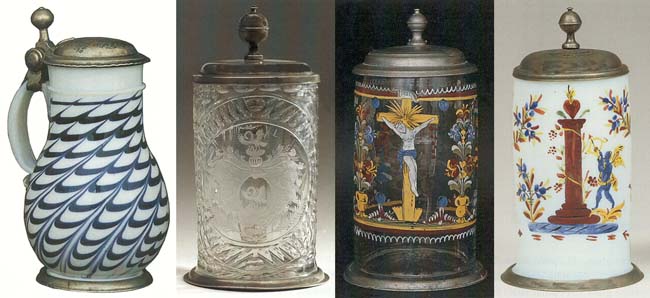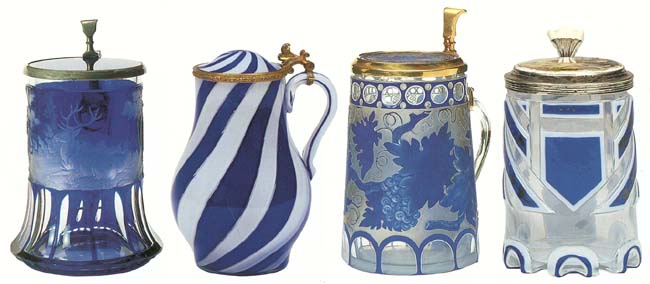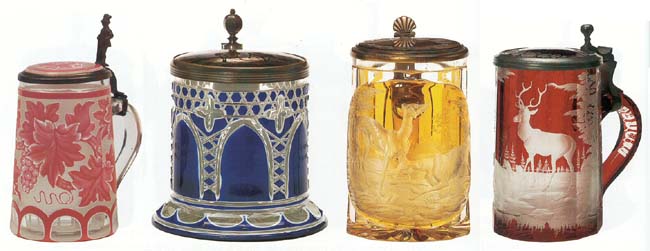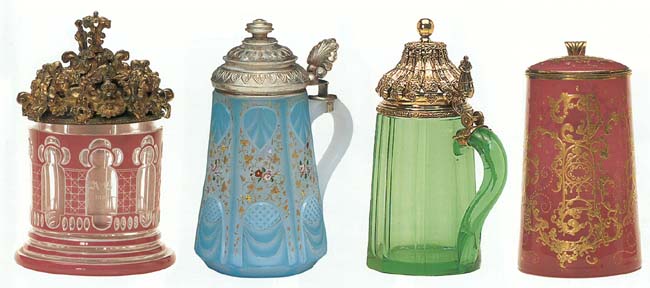Introduction to Glass Steins*
by Gary Kirsner
The History of Glass Steins
The tremendous variety of ways in which glass has been used to produce beer steins makes it very difficult to make generalized comments and select representative pictures. This variety is certainly due to the fact that it is a material that has been known and loved for thousands of years, and thus has received the attention of many innovative craftsmen.
Glass steins dating from the 1530s and 1540s are known. A couple of examples that exist have large finials but no thumblifts. It seems possible that thumblifts, which became popular shortly thereafter, may have been finials displaced to make opening the lid easier.
It is also difficult to make general comments about the materials, shapes, or decorations of steins from the 1500s and 1600s because few examples from this time period are still in existence. The glass is sometimes greenish to brownish in color; sometimes it is milk glass. Some steins have applied glass prunts, while others have enameled portraits or heraldic symbols. The enameled steins show the influence of French and Italian Renaissance designs, readily explained by the fact that the French had reintroduced the lost art of enameling to the Germans in the 1400s, with the Italian influence coming in the middle 1500s.
 |
a. White & blue glass, .5L, probably southern Germany, late 1600s, pewter lid and footring.
b. Clear glass, 1.0L, wheel engraved, middle 1700s, pewter lid and footring.
c. Clear glass, 1.0L, enameled, late 1700s, pewter lid and footring.
d. Milk glass, 1.0L, enameled, late 1700s, pewter lid and footring. |
Enameling glass simply involves the painting of powdered, colored glass, flux, and a vehicle onto glass, then heating at a sufficient temperature to fuse the design to the glass. So-called cold-painting, done with lacquers or oil paints, is known to have been used on early glass steins. It is not durable, however, which may explain why some plain glass bodies have rather elaborate old mountings.
From the late 1600s to about 1800, milk glass was a commonly used porcelain substitute. Milk glass was made by mixing tin oxide, the same white coloring agent used in faience, into the raw materials for glass. The early decorations on milk glass steins, as on many enameled glass items of this period, are similar to those appearing on the faience steins of those times: first Chinese motifs, then the so-called Indian and German flowers, and finally genre scenes. As on faience steins, the style of these motifs changed from the Baroque to folk art by about 1800.
Also in the 1700s, some spectacular engravings were cut into clear and colored glass steins, steins that were almost always cylindrical. Common themes are floral, heraldic, hunting, portraits, celebrations and cities. Some of the earlier themes were mythological or religious.
Silver and pewter mountings were about equally popular on glass steins around 1700. Somewhat later, pewter mountings became far more common. By then, silver mountings were apparently reserved only for spectacular glass steins, such as those that were ornately engraved (often diamond-cut), or those of ruby or cranberry glass (made by using gold as the coloring agent in the glass).
During the Biedermeier period, 1800 to 1850, glass steins began changing from the cylindrical Walzenkrug shape into a shape tapered slightly toward the top and often pulled into a partial pedestal near the base. Enameled folk art designs were used, often featuring wedding scenes or small panels with inscriptions about weddings or commemorating other events. These were probably the most popular steins during this period.
 |
a. Clear glass, .5L, blue stained, wheel engraved, late 1800s, glass inlaid lid.
b. Overlay glass, .5L, clear on blue and white middle 1800s, gilded mounts, glass inlaid lid.
c. Overlaid glass, .5L, Bohemian, wheel engraved, blue and white on clear, middle 1800s, glass inlaid lid.
d. Overlaid glass, .5L, cut, blue and white on clear; late 1800s, porcelain inlaid lid. |
The next period, Historicism, brought a strong interest in Renaissance enameled decorations, occasionally found on cut, and colored glass. Glass that was cut or engraved through one or more different colored layers gained in popularity through the middle 1800s. The section below on “Production” includes information on the techniques used to make these steins, which often depict deer, forests, buildings, geometric patterns, or other folk themes. Geometric patterns created by deep cutting or mold-blown techniques were also popular in the middle 1800s.
Around 1870, elaborate pewter piercework or lattice overlays began to be constructed right over colored glass steins. Toward 1900, the pewterwork became more elaborate and extensive, often encompassing the handle so that the colored glass cup could be separately manufactured and dropped into the pewter shell.
Enamel-decorated steins continued to be popular in the late 1800s and early 1900s, but the themes changed from neo-Renaissance to those with more social significance. Also during this period, a strong interest developed in clear glass steins of every reasonable shape: cylindrical, pedestal, pear, vase, conical, spherical, and all types of combinations. Stein design sometimes included the addition of prunts, cutting, engraving, etching, enameling, or rigaree ribbons.
Such steins have continued to be popular to this day, although the handwork has generally disappeared. Occasionally, modern glass steins will carry an enameled design, which was printed or silkscreened onto a decal that was then fired onto the stein. As with stoneware, there are still a few craftsmen who are making steins using some of the old glassmaking techniques.
Production
Glass is the product of a silicic acid (often from sand) and an alkali (often from soda and ash). The combined ingredients must be brought to a temperature of about 1100°C (2000°F) in order to form a melt. Most glass houses were located in forests because when wood was used as fuel, large quantities of it were required. Some coal-fired glass furnaces were used, but these only became common in the 1800s. Sometime after 1900, electricity became the most popular energy source for glass furnaces.
The earliest glass steins were made by using a long pipe, called a punty or pontil, to remove a blob of glass from the furnace. This piece of glass was then pressed, spun, drawn, and/or blown into a cylindrical shape. The end was trimmed off, and the handle was formed and pressed into place. After some cooling took place, the mug was broken away from the pipe, leaving a pontil mark on the bottom. Even though the rough edges of this mark were often ground smooth, the mark is clearly visible on glass steins made prior to about 1870 and on the handmade steins produced in ever decreasing numbers since then.
 |
a. Overlaid glass, .75L, Bohemian, wheel engraved, pink and white on clear, middle 1800s, glass inlaid lid.
b. Overlaid glass, 1.0L, cut, blue and white on clear, middle 1800s, porcelain inlaid lid.
c. Clear glass, .5L, amber stained, wheel engraved, late 1800s, glass inlaid lid.
d. Clear glass, .75L, ruby stained, wheel engraved, late 1800s, glass inlaid lid. |
A new mold-blown technique, which was developed around 1840, involved putting a partially blown and shaped blob of glass into a mold, then further blowing it until it touched the sides and picked up the pattern of the mold. Steins from such three-part molds, or dip molds, have soft contours, unlike sharper pressed or cut glass, and they still have pontil marks. This type of mold-blown glass stein can also be identified by hollows and patterns on the outside that to some extent correspond to patterns inside the stein. Sand spots, bubbles (or seeds), swirls, or streaks may often be seen in these steins, as in all earlier handmade glass. The sizes are usually regular, such as .25L, .5L, and 1.0L. The lids are the same as those characteristic of most steins made from about 1840 to 1880: porcelain inlaid, cut glass inlaid, or heavy steepled pewter, occasionally with faceted colored glass jewels.
In the middle of the 1800s, the demand for glass bottles and jars generated tremendous economic incentive to invent a bottle-making machine. The widespread use of coal as an abundant furnace fuel made such mass production possible. By the 1870s, automatic machinery had replaced the mold-blown processes, creating the so-called pressed glass steins. Nearly always made of clear glass, these steins are usually seen with the same types of lids as the moldblown steins. Into the 1900s, the pewter lids became markedly less heavy and less ornate.
Colors are imparted to glass intentionally or unintentionally by the presence of metal oxides. As previously mentioned, the iron oxide in sand and other raw materials imparts a greenish blue tinge. Metallic impurities in wood ash tend to produce a grayish-green tint. Colors that may be used intentionally include:
• cobalt oxide for royal blue;
• manganese oxide for violet;
• chromium oxides and nickel oxides for greens;
• tin oxides for milk (or white);
• gold for cranberry;
• silver for gray;
• copper sulfate for turquoise;
• cadmium oxides for red.
Most of these colors were available in the 1200s, long before steinmaking started, and were subsequently refined during the Medicis’ synthetic gem experiments and by other later experimentation with colored glass for stained glass windows.
 |
a. Overlaid glass, .75L, cut, pink and white on clear, middle 1800s, gilded lid.
b. Opaline glass, .5L, blue, enameled, late 1800s, silver lid.
c. Uranium glass, .5L, faceted, middle 1800s, gilded lid.
d. Opaline glass, .5L, pink, enameled, late 1800s, glass inlaid lid. |
Some other techniques can be used to add color to glass. If a blob of molten clear glass is touched to a blob of another color, usually red, blue, violet, green, or yellow, it will pick up a thin outer layer of that color. This layer can then be engraved, cut or etched through to the clear glass using hydrofluoric acid. Some beautiful steins have been produced using multiple layers of this overlaid glass.
Clear or colored glass can also be stained with silver nitrate or some other products that are fired into the surface layers of the glass. These stains are always in the range from light yellow to orange-yellow, and they can be engraved, cut, or etched through to clear in ways similar to the techniques used on overlaid glass.
Flashed glass has a thin layer of colored, translucent enamel fired onto its surface. Most often the enamel is a ruby color with a slight bluish surface sheen. Flashed glass is easily cut through to clear to provide decorative effects, such as scenes of spas, buildings, or deer.
Of these three types of surface colors, the overlay is the richest, most even, and most difficult to produce. Compared to the other two techniques, it can easily be identified by its noticeable thickness at all places where it has been cut through.
As beautiful as colored glass can be, the quest for a formula for any specific color pales in comparison to the fanatical search for a perfectly clear glass. Surprisingly pure raw materials are required to make a glass of so-called superior brilliance. Even using an iron tool to stir the raw materials for glass is enough to impart to the glass that common greenish-blue tinge of iron oxide.
In the middle 1800s, it became common to mask this iron oxide tint with small quantities of manganese oxide, but this decolorizer becomes unstable in sunlight and changes to light purple. Manganese became a strategic mineral during World War I, and since it was unavailable for glass manufacture, it was replaced by the straw-colored selenium. Since the late 1920s, whenever a reasonably clear glass was desired without incurring the expense of using a crystal recipe, traces of selenium and cobalt (bluish) were mixed to yield a glass with a very light gray color. Looking into the edge of the base, or the lip, for a concentrated view of the color of the glass can help identify the period during which a clear glass stein was made.
Collecting Glass Steins
The Historicism style of the 1800s led to the reproduction of many Renaissance enameled glass pieces. However, few were steins (most were beakers and pokals, often with the Imperial Eagle motif). Streaks and seeds in the glass and the great attention to the design detail of the originals are the best ways of identifying age. Enameled names of reproduction manufacturers were frequently polished off.
The most difficult copies to detect are those that use authentic old glass bodies, originally decorated very sparsely or polished clean but later enameled using old designs. To properly bake such enamel designs onto a stein, however, requires the removal and reattachment of the mountings, a procedure that can usually be easily detected.
The same types of identification problems are encountered with reproduction engraved glass steins, and the same solutions are applicable, i.e., examining the detail of the engraving, replaced lids, and so on.
Care of glass steins is simple but important. To protect against damage from heat, they should be kept out of direct sunlight and away from fireplaces, stoves, and furnace vents when these are in use. The very old and very thin-walled steins are especially vulnerable.
Recent Price Trends
The great variety of available glass steins make it difficult for most collectors to gain a comprehensive appreciation for the overall pricing structure or to accumulate a wide-ranging collection, leading most to specialize in a limited number of types.
In general, price trends in the past ten years have tended upward for glass steins. Most glass steins from the 1700s and early 1800s have increased in value, some significantly. Many of the more desirable glass steins from the middle 1800s, including overlay and the better wheel-engraved steins, have similarly increased in value. Prices for the more common transfer glass steins have been steady or are increasing only slightly.
__________
*Reprinted by permission from The Beer Stein Book: a 400 Year History, 3rd edition, 1999, Glentiques, Ltd., Coral Springs, FL.




